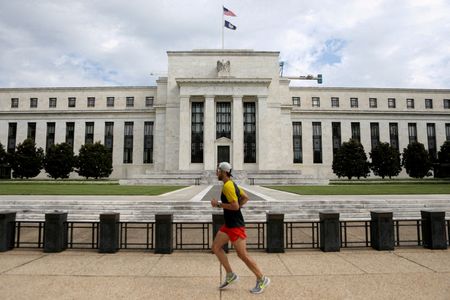By Michael S. Derby and Dan Burns
WASHINGTON (Reuters) – Federal Reserve officials last month were strongly leaning toward an interest rate cut at their September policy meeting and several of them would have even been willing to reduce borrowing costs immediately, according to the minutes of the July 30-31 gathering.
U.S. central bank officials left interest rates unchanged at the Federal Open Market Committee meeting last month but opened the door to a cut at the Sept. 17-18 session. For some time, financial markets have been expecting the September meeting to kick off the reductions in the federal funds rate, which is currently set in the 5.25%-5.50% range. As much as a full percentage point worth of easing is expected by the end of this year.
At the July meeting, “the vast majority” of policymakers “observed that, if the data continued to come in about as expected, it would likely be appropriate to ease policy at the next meeting,” said the minutes, which were released on Wednesday.
They also noted “many” Fed officials viewed the stance of rates to be restrictive and “a few participants” contended that amid an ongoing cooling in inflationary pressures, no change in rates would mean that monetary policy would increase the drag on economic activity.
The minutes said that while all Fed officials were on board with keeping rates steady in July, “several” policymakers said that progress on lowering inflation amid a rise in joblessness “had provided a plausible case for reducing the target range 25 basis points at this meeting or that they could have supported such a decision.” The minutes also showed that a dwindling camp of policymakers feared a premature easing in monetary policy could restart inflation.
The case for cutting rates rests on the ebbing of price pressures back to the central bank’s 2% target and increased anxiety about the state of the job market in the wake of recent data showing a rise in the unemployment rate.
The speed of the jump in the jobless rate, which bottomed at 3.4% early last year and has since climbed to 4.3% as of last month, has added urgency to the debate over rate cuts and has prompted some analysts to say that a half-percentage-point reduction in borrowing costs should be considered next month.
The minutes noted that officials see the job market as having largely returned to where it was before the COVID-19 pandemic started, and described the job market as “strong but not overheated.”
Markets showed little reaction, with stocks rising modestly and bond yields falling, as the minutes appeared to largely confirm the policy outlook traders and investors have already priced into their securities holdings. Fed funds futures were largely unchanged from before the release.
BALANCE OF RISKS
The Fed’s concerns about the job market may be exacerbated by the Labor Department’s estimate on Wednesday that 818,000 fewer payroll jobs existed in March than previously reported. The change was part of the annual benchmark revision process.
The minutes noted that a “majority” of Fed officials saw risks to the job market as having increased while risks to the inflation mandate had been reduced.
In his post-meeting press conference last month, Fed Chair Jerome Powell tipped off the likely outlook by saying “if we do get the data that we … hope we get, then a reduction in our policy rate could be on the table at the September meeting.”
The current level of joblessness is already higher than the 4% level Fed officials penciled in for this year in their updated economic projections in June, and the 4.2% policymakers projected for the end of next year.
Markets are likely to get an update of Powell’s views on Friday when he speaks at the Kansas City Fed’s annual research conference in Jackson Hole, Wyoming. A number of other Fed officials are also likely to weigh in on the outlook while attending the conference.
(Reporting by Michael S. Derby; Additional reporting by Lindsay Dunsmuir; Editing by Paul Simao)





